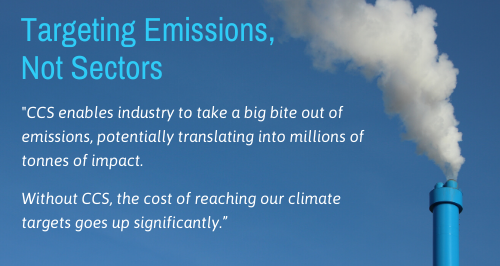as published in The Globe & Mail January 9, 2020
Rising levels of carbon-dioxide (CO2) concentration in the global atmosphere have made curbing emissions a universally acknowledged priority. Yet meeting the ambitious targets of the Paris Agreement requires substantial measures. Beth Hardy, vice-president of Strategy & Stakeholder Relations at the International CCS Knowledge Centre, envisions carbon capture and storage (CCS) to be part of the solution.
Addressing climate change demands actions at every level, she explains. “We need everything, from personal changes like recycling and winterizing your home to clean energy sources and tackling big industrial emissions.”
That’s where CCS can help, says Ms. Hardy. “It enables industry to take a big bite out of emissions, potentially translating into millions of tonnes of impact. Without CCS, the cost of reaching our climate targets goes up significantly.”
Of the Intergovernmental Panel on Climate Change’s four mitigation pathways towards limiting warming to 1.5 degrees Celsius above pre-industrial levels, only one – “the austerity model – doesn’t rely on CCS,” she says. “Having a consistent quality of life during the transition away from fossil fuels definitely requires CCS.”
With a mandate to advance the understanding of large-scale CCS, the Knowledge Centre draws on direct experiences from the world’s first CCS facility attached to a commercial coal-burning power station: SaskPower’s Boundary Dam 3 (BD3) near Estevan, Saskatchewan. Having surpassed three million tonnes of captured CO2 during its five years of operation, the facility illustrates CCS’s potential for reducing emissions from burning coal, which is currently used to generate about 38 per cent of the world’s electricity.

The Knowledge Centre’s Shand CCS Feasibility Study looked at the business case for post-combustion carbon capture retrofits, demonstrating a reduction of capital costs to 67 per cent per tonne of CO2 captured, due to insights into modularization, layout and integration.
The technology’s efficacy in tackling post-combustion emissions also makes it useful beyond fossil fuel electricity generation; for example, for processes to manufacture cement, iron, steel and fertilizer, notes Ms. Hardy.
A recently announced partnership between the Knowledge Centre and Lehigh Hanson envisions the integration of large-scale CCS with a cement production facility, she says. “With cement accounting for eight per cent of global CO2 emissions, this industry represents significant potential.”
Ms. Hardy looks forward to presenting this perspective at GLOBE 2020. “Much of the current conversation is focused on getting rid of fossil fuels, but we can actually clean them up while we transition to cleaner technologies,” she says. “The goal isn’t to phase out coal – it’s to phase out coal emissions, and that’s the same for oil and gas and other industries. We’re not targeting these sectors – we’re targeting their emissions.”
This message resonates with community partners, says Ms. Hardy. “Global emissions reduction is important right down to the community level. The people who work at CCS projects and facilities understand this and are very proud of what has been achieved.”
Please note: The content and external links within this article do not constitute an endorsement or an approval by the International CCS Knowledge Centre (Knowledge Centre) of any products, services, or opinions of the authoring corporation, organization, or individual. The Knowledge Centre bears no responsibility for the accuracy, legality, or content of the external site or for that of subsequent links.
